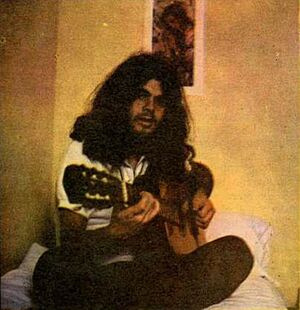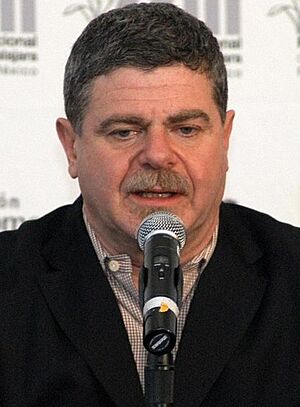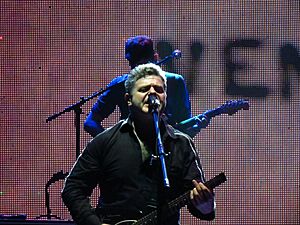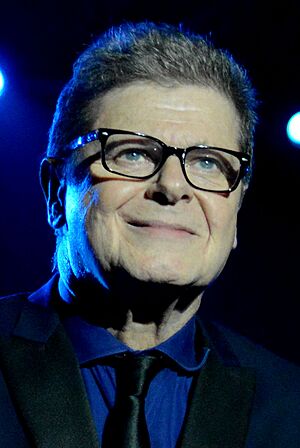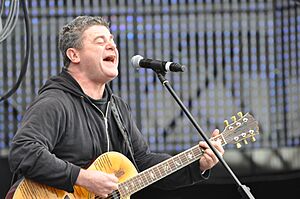Gustavo Santaolalla facts for kids
Quick facts for kids
Gustavo Santaolalla
|
|
|---|---|
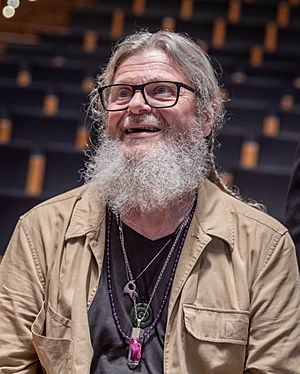
Santaolalla in 2022
|
|
| Background information | |
| Birth name | Gustavo Alfredo Santaolalla |
| Born | 19 August 1951 El Palomar, Argentina |
| Origin | Buenos Aires, Argentina |
| Genres | |
| Occupation(s) |
|
| Instruments |
|
| Years active | 1967–present |
Gustavo Alfredo Santaolalla (born 19 August 1951) is a famous Argentine composer, music producer, and musician. He has won many important awards for his work. These include two Academy Awards for Best Original Score, a Golden Globe, two Grammy Awards, and 17 Latin Grammy Awards. He is known for his simple, yet powerful, way of creating music. He has also greatly influenced Latin rock music.
Gustavo started his music career early, forming the band Arco Iris in 1967. This group was very important for the rock nacional music style in Argentina. Later, he moved to Los Angeles in 1978. After returning to Argentina, he became a key figure in the rock en español movement. He produced music for over 100 artists. In 2001, he started the neotango group Bajofondo.
His solo album Ronroco (1998) caught the attention of filmmakers. This led him to start composing music for movies. His first film scores included Amores perros (2000), 21 Grams (2003), and The Motorcycle Diaries (2004). He became very famous for his scores for Brokeback Mountain (2005) and Babel (2006). For these, he won two Academy Awards in a row.
Gustavo Santaolalla also gained recognition for his work on The Last of Us video game series. He composed music for the 2013 game and its 2020 sequel. In 2014, he composed his first animated film, The Book of Life. He also scored his first Argentine film, Wild Tales. He returned to compose music for The Last of Us TV show in 2023.
Gustavo does not read or write traditional music notes. He prefers to compose by himself, focusing on simple sounds. He often uses instruments like the ronroco. He likes to capture the human feeling in his music. His live performances are known for being very energetic. He was honored as a BMI Icon in 2008 and received the Latin Grammy Trustees Award in 2023. Outside of music, he enjoys winemaking.
Contents
Early Life and First Steps in Music
Gustavo Alfredo Santaolalla was born in El Palomar, Argentina, on 19 August 1951. His mother stayed at home, and his father worked in advertising. His family has roots in Spain. When Gustavo was five, his grandmother gave him his first guitar for his birthday. He felt an instant connection to music and started taking lessons.
When he was ten, his teacher stopped teaching him. The teacher told his mother that Gustavo's "ear is stronger than my music," meaning he learned by listening. Gustavo also lived in the community of Ciudad Jardín Lomas del Palomar. As a pre-teen, he wrote songs in English, inspired by bands like the Beatles. At twelve, he received his first electric guitar.
In his teenage years, Gustavo dreamed of becoming a musician. He even designed a logo for a record label he hoped to own one day. During his teenage years, he faced challenges from the government. He was arrested several times, which continued throughout his youth. His father supported him during these difficult times.
Music Journey and Film Scores
Starting with Bands and Solo Work
Gustavo Santaolalla's music career began in 1967. He helped start the rock band Arco Iris. This band was very important in creating the rock nacional style in Argentina. He played guitar and sang in the band. The group included other talented musicians like Ara Tokatlian and Guillermo Bordarampé. They lived a simple, shared lifestyle, focusing on Eastern religion and healthy habits. They became well-known with their song "Mañana campestre."
After seven albums with Arco Iris, Gustavo left the band. He felt the group's lifestyle had become too strict. He then formed a new rock group called Soluna. In 1978, he moved to Los Angeles, California, during a tough time in Argentina. He formed another group called Wet Picnic, but they did not have much success. He described this period as very challenging.
In the mid-1980s, Gustavo returned to Argentina. He traveled through the countryside with his friend, folk musician León Gieco. This trip was called "De Ushuaia a la Quiaca." They traveled from the very south to the very north of Argentina. Their goal was to discover and experience traditional folk music. This journey helped Gustavo embrace these musical styles in his own work. He especially loved the ronroco, a ten-string instrument from the Andes mountains.
Gustavo released his solo album Santaolalla in 1982. He became a key figure in the rock en español movement, especially in Mexico. The Los Angeles Times called him "the most transcendent producer" in Latin rock history. He worked with co-producer Aníbal Kerpel to produce albums for many artists. These included Café Tacvba, Julieta Venegas, Molotov, and Juanes. Gustavo said he produced over 100 records for artists who were "searching for their identity through music." In 1998, he released Ronroco, an album of solo works recorded over 14 years. It featured the ronroco, charango, and Andean pan flute. In 2001, he formed the neotango group Bajofondo, where he plays guitar.
Becoming Famous with Film Scores
The album Ronroco brought Gustavo Santaolalla to the attention of filmmakers. This led him to start composing music for movies. Director Michael Mann used Gustavo's song "Iguazu" in his film The Insider (1999). Mexican director Alejandro González Iñárritu heard Ronroco and asked Gustavo to compose for his films Amores perros (2000) and 21 Grams (2003). This started a long partnership between them. Gustavo said he had "no plan" to get into film scores, but he "always had this love for films." He also wrote the music for Walter Salles's film The Motorcycle Diaries (2004). For this, he won an award at the 58th British Academy Film Awards.
Gustavo composed the music for the film North Country (2005). That same year, he created the instrumental music for Brokeback Mountain. The director, Ang Lee, wanted a simple and "yearning" sound for the film. Gustavo composed almost all the music before filming even began. For Brokeback Mountain, he composed the song "A Love That Will Never Grow Old." This song won the 2006 Golden Globe Award for Best Original Song. Gustavo also composed the music for the 2006 film Babel, working again with Iñárritu.
Gustavo Santaolalla won the Academy Award for Best Original Score for Brokeback Mountain in 2006 and for Babel in 2007. Winning two years in a row made him a very well-known Hollywood composer. He was honored as a BMI Icon in 2008. He composed music for the films I Come with the Rain (2009) and Biutiful (2010).
Gustavo composed the music for the 2013 video game The Last of Us. The game's creators, Neil Druckmann and Bruce Straley, loved his music. They realized he had composed many of the songs they found inspiring. When they asked him to work on the game, Gustavo immediately said, "I want to be a part of this." He had always wanted to compose for video games, but only for projects with strong stories and characters. He sent them music for nearly three years. He challenged himself by using unique instruments, which added "an element of danger and innocence" to the sound.
In November 2013, Gustavo toured Mexico with Bajofondo. They performed at several festivals to support their album Presente. At the 14th Annual Latin Grammy Awards, Bajofondo won the award for Best Instrumental Album for Presente. Their song "Pena en mi Corazón" also won Best Alternative Song.
Recent Work with Scores and The Last of Us Part II
Gustavo composed music for the musical Arrabal, which opened in February 2014. He also composed the music for the 2014 animated film The Book of Life. This was his first animated film and his first time working with a large orchestra and choir. He used instruments like the marimba and accordion, along with mariachi horns. This was a change from his usual simple style. He also wrote songs for the film with Paul Williams. Gustavo felt the film was "fantastic" because of its authentic music and open way of showing life and death. He also composed the music for Wild Tales (2014), his first score for an Argentine film.
Gustavo composed the music for the animated short film Borrowed Time (2015). The directors were fans of The Last of Us and loved his use of silence in the music. Gustavo agreed to work with them after seeing an early version of the film. In October 2015, he was honored by the Latin Songwriters Hall of Fame. He also helped compose the music for the 2016 documentary film Before the Flood. He scored the French film All That Divides Us (2017).
Gustavo returned to compose the music for The Last of Us Part II (2020), the sequel to the video game. He worked on the game for two to three years, creating emotional music for the characters. He continued to use the ronroco for the main character, Ellie. He also added a banjo for a new character, Abby. He used the banjo and an electric guitar to create more varied sounds for the game's complex story. He also worked with Gary Clark Jr. on the song "Valley of Last Resort" for a documentary film.
The Last of Us TV Series and Other Projects
Gustavo Santaolalla returned to compose music for the television show based on The Last of Us, which premiered in 2023. He felt his return was necessary because of the strong connection fans had with the game's music. He mainly reworked his existing music from the game, adapting it to fit the TV show's scenes. He saw the series as an "expansion" of the game, keeping them closely linked. He created about 185 musical pieces for the show, each linked to specific actions or moments. He worked with David Fleming, who helped choose instruments that matched Gustavo's style. In 2023, Gustavo also performed at Eric Clapton's Crossroads Guitar Festival. He received the Latin Grammy Trustees Award in November 2023.
In 2024, Gustavo composed new music for special screenings of the 1931 Spanish-language Dracula film. The Los Angeles Opera asked him to create this score. He wanted to mix traditional orchestra sounds with experimental electronic music. He felt his music would add to the film's characters, as the original film had no music. He used synthesisers and samplers along with the orchestra to give the music "potency." Gustavo said he kept a feeling of "innocence" with the project, making sure to have fun.
In 2025, Gustavo returned to compose music for The Last of Us season 2. He even made a small appearance in the first episode, playing with the band Crooked Still. The show's co-creator, Craig Mazin, thought it would be a great idea to include him in the scene. Gustavo enjoyed the experience, even though it involved long days of filming.
Artistic Style
Gustavo Santaolalla does not know how to read or write traditional musical notation. When he was young, he had to memorize all his songs because he couldn't write them down. His parents bought him a tape recorder, which he used to save his music. When he works with an orchestra, he still records his compositions. Then, an orchestrator writes them down on paper. Gustavo believes composing and performing his music mostly by himself gives it more "character" and "personality."
Gustavo often starts composing music early in a film's production, based on the script. This allows him to have a bigger creative role. He creates music based on his connection to the story and characters. PBS describes his music as "melancholy and minimal." Gustavo told the Los Angeles Times that a touch of sadness is "ever present" in his work. However, his live performances are described as "vivacious and buoyant," meaning lively and cheerful.
Gustavo often uses silence in his music. He says that empty spaces make the notes around them more powerful. He compares his music process to parkour, where athletes carefully plan their jumps. He feels it's important to choose each note carefully, like landing safely in parkour. Gustavo likes to capture the sounds of instruments being played, like fingers sliding on guitar strings. He finds this "primitive" sound adds "tension and texture" and "humanity" to his music. His special instrument is the ronroco, which he discovered while exploring music in the Andes mountains.
Personal Life
Gustavo Santaolalla is married to Alejandra. They have a daughter named Luna, who studied viticulture (the science of growing grapes) at the University of California Davis. They also have a son named Don Juan. Gustavo has been involved in winemaking since the mid-2000s. He owns a farm called La Luna in Argentina with Raúl Orozco.
Awards and Achievements
Gustavo Santaolalla has received many awards for his work. He has won two Academy Awards for Best Original Score. He has also won a Golden Globe and two Grammy Awards. He has received an impressive 17 Latin Grammy Awards. In 2008, he was recognized as a BMI Icon. In 2023, he received the Latin Grammy Trustees Award for his great influence in Latin music.
See also
 In Spanish: Gustavo Santaolalla para niños
In Spanish: Gustavo Santaolalla para niños


